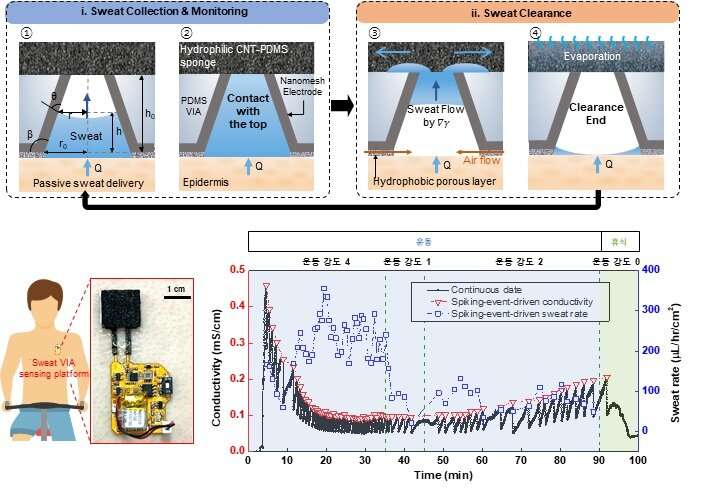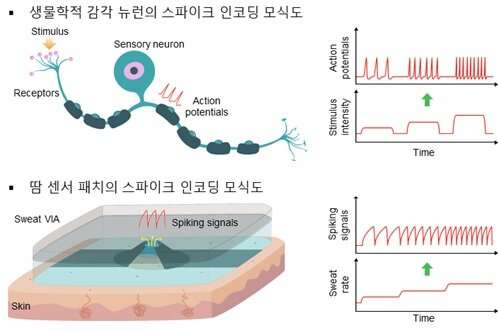This article has been reviewed according to Science X's editorial process and policies. Editors have highlighted the following attributes while ensuring the content's credibility:
fact-checked
peer-reviewed publication
proofread
Development of a low-power, long-term sweat sensor patch that imitates sensory neurons

Human sweat contains chemical information including blood metabolites, ion concentrations, and nutrients. Monitoring this information using a wearable sensor can allow non-invasive (i.e., without blood sampling), real time health status tracking. For example, knowing sweat volume and ion concentrations can help people maintain adequate water and sodium levels during physical activities, and can prevent hypoglycemic shock by identifying symptomatic excessive sweating.
Since a wearable sweat sensor patch generates a large amount of redundant data due to real-time continuous data wireless transmission and consumes a considerable amount of energy, it has been difficult to achieve sufficient operating time to render its use practical.
Dr. Hyunjung Yi's research team at the Center for Spintronics and professor Rhokyun Kwak's research team at the Hanyang University Department of Mechanical Engineering have developed a wearable sweat sensor patch with dramatically improved energy efficiency that can operate for more than 24 hours by imitating the efficient information processing method of sensory neurons.
When a human sensory neuron receives external stimuli, it translates the information into spike signals. External stimulus strength is directly proportional to spike signal frequency. This event-based spike signal processing method used by neurons enables efficient, fast, and accurate processing of massive amounts of complex external stimulus data. If this "event-based wireless monitoring" method used by human sensory neurons is applied, data is only transmitted when important events related to the user's health indicators occur, minimizing energy consumption by the wireless monitor.

These research teams have developed a wireless wearable sweat sensor patch that imitates the "spike signals" of sensory neurons and has demonstrated in clinical trials the ability to dramatically reduce energy consumption through event-based wireless monitoring. Sweat is structured by the patch in a way that places a sweat removal layer on top of a conical open vertical sweat channel that can rapidly remove the sweat filling in the channel (see figure above).
Each sweat channel inner wall harbors a pair of electrodes, allowing conversion of the process of sweat filling the channel and getting removed into electrical signals. Electrical signals increase when channels are filled, and rapidly decrease each time the sweat is instantaneously removed. As this process is repeated, a spike-form signal is created. The frequency and amplitude of the spike signals carry interpretable information on the speed of sweat excretion and the concentration of sweat ion components.
Through the repeated process of filling and emptying, the sweat sensor can operate continuously for a long period of time, and since newly secreted sweat is not mixed with preexisting sweat, the sensor can deliver accurate information. The research teams have experimentally proven that the energy consumption of this event-based data transmission method is only 0.63% of the energy consumption of continuous data transmission, allowing the developed wearable sweat sensor patch to operate continuously for more than 24 hours. Information from sweat on various skin surfaces in real exercise situations has successfully been obtained in clinical trials.
Development of this patch enables long-term sweat monitoring that can be used to detect acute diseases or their precursors, such as nocturnal hypoglycemic shock and heart attack. The sensing method is expected to enable more energy-efficient and intelligent digital health management by application to other types of skin-attached sensors and adoption of new computing technologies.
The research was published in the journal Nature Communications.
More information: Sangha Kim et al, An epifluidic electronic patch with spiking sweat clearance for event-driven perspiration monitoring, Nature Communications (2022). DOI: 10.1038/s41467-022-34442-y




















